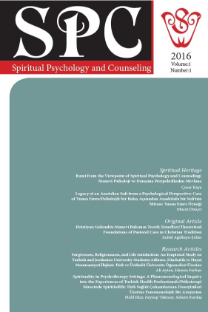A White Counselor in a Multicultural World: Understanding the Need for a Spiritual, Multicultural Counseling Course
Multicultural counseling must be seen a significant factor in today’s multicultural world as therapists provide therapeutic services offered to clients, especially clients who have immigrated from one country to another within the past 50 years. Multicultural counseling refers to the preparation and practices that help White counselors learn to integrate multicultural and culture-specific awareness, knowledge, and skills into counseling interactions into their practice with multicultural clients. White counselors who work with multicultural clients have the choice to either remain handmaidens of the status quo or transmitters of society’s values or become agents of change. Additionally, it has been demonstrated that White counselors who have participated in a multicultural training program have greater therapeutic skill to offer their multicultural clients. Furthermore, when multicultural counseling is incorporated in a spiritually-enriched therapeutic relationship, White counselors are able to relate more effectively with their multicultural clients. A spiritually-enriched therapeutic relationship offers counselors the opportunity to work with their multicultural clients and incorporate the vital aspect of spirituality, because it is universal to human existence. Therefore, through the use of spirituality in multicultural counseling, White counselors must have the desire to understand their multicultural clients’ worldview, which incorporates the view these clients have of their spirituality. Counselors must understand the importance of developing a curiosity to understand how spirituality influences the lives of their multicultural clients and use this new awareness to help facilitate healing and wholeness for their clients.
Keywords:
Ethnocentric, Ethnorelative, Multicultural Counseling Spirituality,
___
- Ahmed, S., Wilson, K.B., Henriksen, R.C., & Jones, J.W., (2011). What does it mean to be a culturally competent counselor? Journal of Social Action in Counseling and Psychology, 3(1), 17-28. Retrieved from https://eds-b-ebscohost-com.xxproxy.smumn.edu/eds/detail/detail?vid=1&sid=a93252c3-7a14-4fbf-9657-e72ea2d25bf7%40sessionmgr120&bdata=JnNpdGU9ZWRzLWxpdmU%3d#AN=77572699&db=aph
- American Psychological Association (APA). (2010). Publication manual of the American Psychological Association (6th ed.). Washington, D.C.: American Psychological Association.
- Allport, G.W. & Odbert, H.S. (1936). Trait names: A psycholexical study. Psychological Monographs, 47, 211.
- Arredondo, P., Toporek, M. S., Brown, S., Jones, J., Locke, D. C., Sanchez, J., & Stadler, H. (1996). Operationalization of the multicultural counseling competencies. Journal of Multicultural Counseling and Development, 24(1). Retrieved from https://eds-b-ebscohost-com.xxproxy.smumn.edu/eds/detail/detail?vid=1&sid=a838283f-7177-4d13-ab0b-2fd682657cf7%40pdc-v-sessmgr05&bdata=JnNpdGU9ZWRzLWxpdmU%3d#AN=RN021540924&db=edsbl
- Arredondo, P. & Arciniega, G.M. (2001). Strategies and techniques for counselor training based on the multicultural counseling competencies. Journal of Multicultural Counseling and Development, 29(4). 263-273. Retrieved from https://onlinelibrary.wiley.com/doi/abs/10.1002/j.2161-1912.2001.tb00469.x. doi:10.1002/j.2161-1912.2001.tb00469.x.
- Barden, S.M., Shannonhouse, L., & Mobley, K. (2015). International cultural immersion: Assessing the influence of a group intervention on intercultural sensitivity for counselor trainees. The Journal for Specialists in Group Work, 40(1), 117-141. Retrieved from https://eds-b-ebscohost-com.xxproxy.smumn.edu/eds/pdfviewer/pdfviewer?vid=8&sid=a93252c3-7a14-4fbf-9657-e72ea2d25bf7%40sessionmgr120. doi:10.1080/01933922.2014.992505
- Bean, R.A. & Titus, G. (2009). Cultural intersection of Asian Indian ethnicity and presenting problem: Adapting multicultural competence for clinical accessibility. Journal of Multicultural Counseling and Development, 37(1). Retrieved from https://eds-b-ebscohost-com.xxproxy.smumn.edu/eds/pdfviewer/pdfviewer?vid=5&sid=c4fcfcec-2f85-4cb5-8593-fe3e4b7f098d%40sessionmgr103
- Berger, L.K., Zane, N., & Hwang, W. (2014). Therapist ethnicity and treatment orientation differences in multicultural counseling competencies. Asian American Journal of Psychology, 5(1), 53-65. Retrieved from https://eds-b-ebscohost-com.xxproxy.smumn.edu/eds/pdfviewer/pdfviewer?vid=11&sid=a93252c3-7a14-4fbf-9657-e72ea2d25bf7%40sessionmgr120.
- Bhawuk, D. P., & Brislin, R. (1992). The measurement of intercultural sensitivity using the concepts of individualism and collectivism. International Journal of Intercultural Relations, 16(4), 413-436. Retrieved from https://www.sciencedirect.com/science/article/abs/pii/014717679290031O http://dx.doi.org/10.1016/0147-1767(92)90031-O
- Brach, C. & Fraser, I. (2000). Can cultural competencies reduce racial and ethnic health disparities? A review and conceptual model. Medical Care Research and Review, 67(1), 181-217. Retrieved from https://www.ncbi.nlm.nih.gov/pmc/articles/PMC5091811/. doi: 10.1177/1077558700057001S09
- Caffrey, C. (2018). Vicarious traumatization (VT). Salem Press Encyclopedia of Health. Retrieved from https://eds-a-ebscohost-com.xxproxy.smumn.edu/eds/detail/detail? Vid=1&sid=bd59064b-5158-4439-a189-4ec9f127ebf8%40sdc-v-sessmgr03&bdata=JnNpdGU9ZWRzLWxpdmU%3d#AN=100259369&db=ers
- Center for Substance Abuse Treatment (2016). Improving Cultural Competence. SAMHSA. Retrieved from https://www.ncbi.nlm.nih.gov/books/NBK248428/
- Cole, E.M., Piercy, F., Wolfe, E.W., & West, J.M. (2014). Development of the multicultural therapy competency inventory-client version. Contemporary Family Therapy, 36(4), 462-473. Retrieved from https://eds-b-ebscohost-com.xxproxy.smumn.edu/eds/pdfviewer/pdfviewer?vid=23&sid=a93252c3-7a14-4fbf-9657-e72ea2d25bf7%40sessionmgr120. doi:10.1007/s10591-014-9320-8
- Dawson, G. (2017). Therapeutic alliance: A better diagram. Real Psychiatry. Retrieved from https://www.google.com/search?q=diagram+of+an+ethical+working+alliance&tbm=isch&source=iu&ictx=1&fir=IW3ew6s_l_vCaM%253A%252CrKJxYL20ClBrJM%252C_&usg=AI4_-kQ1613dQTmTyCLkL1wSAzn5cXOvEQ&sa=X&ved=2ahUKEwiZ2OPxreHfAhVK74MKHYhLCoUQ9QEwA3oECAAQCg#imgrc=IW3ew6s_l_vCaM:
- Gladding, S.T. (2004). Counseling: A comprehensive profession (5th ed.). Upper Saddle River, NJ: Pearson.
- Gladding, S.T., Remley, T.P., & Huber, C.H. (2001). Ethical, legal, and professional issues in the practice of marriage and family therapy (3rd ed.). Upper Saddle River, NJ: Merrill Prentice Hall.
- Goodman, R.D.; Vesely, C.K.; Letiecq, B.; & Cleaveland, C.L. (2017). Trauma and resilience among refugee and undocumented immigrant women. Journal of Counseling & Development, 95(3), 309-321. Retrieved from https://eds-b-ebscohost-com.xxproxy.smumn.edu/eds/detail/detail?vid=1&sid=eeeeb7b1-c8d4-4cab-a016-6c8009af9b84%40sessionmgr101&bdata=JnNpdGU9ZWRzLWxpdmU%3d#AN=123715847&db=tfh. doi: 10.1002/jcad.12145
- Hays, P.A. (2008). Addressing cultural complexities in practice: Assessment, diagnosis, and therapy (2nd ed.). Washington, D.C.: American Psychological Association.
- Hays, P.A. (2014). An intercultural perspective on the adaptation of CBT across cultures. Australian Psychologist, 49(1), 17-18. Retrieved from http://onlinelibrary.wiley.com/doi/10.1111/ap.12027/full. doi:10.111/ap.12027
- ISSN: 2458-9675
- Yayın Aralığı: Yılda 3 Sayı
- Başlangıç: 2016
- Yayıncı: Halil Ekşi
Sayıdaki Diğer Makaleler
Duygu Odaklı Çift Terapisi ve Maneviyat
Y Kuşağında Algılanan Stres ve Dini Tutumun Yaşam Doyumu Üzerindeki Etkisi
Süleyman KAHRAMAN, Elif Tuğçe YASİN, Furkan Onur EKEN
ALİ BALTACI, Semra Nurdan YAĞLI SOYKAN
Okul Yöneticilerinin Ruhsal Liderlik Stilinin Okul Kültürüne Etkisi
